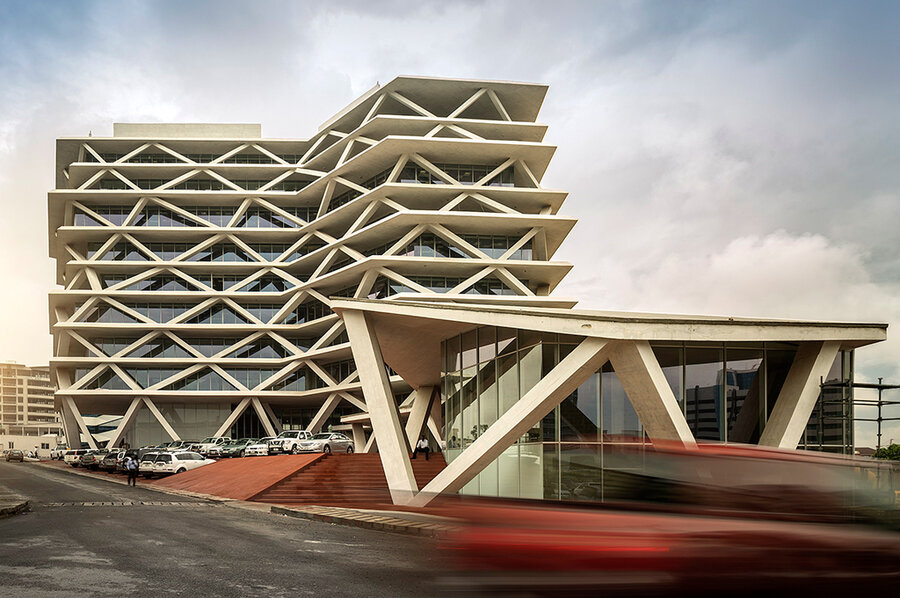Reshaping colonial cities, African architects reclaim history – and the future
Loading...
| Johannesburg, South Africa
For decades, crammed neighborhoods of matchbox houses and tin shacks lined the edges of South Africa’s cities like grand human filing cabinets: places the white government could store the vast quantities of black labor it needed to keep the country going.
When these "townships" of workers – forbidden from living in the cities proper – got too crowded, too diverse, or too revolutionary, the government would often simply tear them down and start over.
Today, however, these architectural afterthoughts have become the sites of some of the country’s most creative and forward-thinking design projects – buildings that seem by their very existence to demand a new way of seeing places once confined to the margins of both South Africa’s cities and its history.
Among these projects is the airy and elegant community history museum that now soars above the township of Cato Manor in Durban, a coastal city here. And on Thursday night, the Umkhumbane Museum took the grand prize in the Africa Architecture Awards, the first ever pan-African award for building design.
“We come from a deep history of pain and suffering, but also a deep history of resilience,” says Rod Choromanski, the lead architect on the project. “And we want to show people how important their lives and histories are.”
In a wider sense, too, many of the award’s finalists embody a continent whose architects are simultaneously reclaiming a design history snuffed out – often violently – by colonialism while also creating spaces that are asserting Africa loudly in the global architecture world.
Reimagined spaces
Finalists for the main award included a cultural center in rural Senegal whose thatched roof undulates like a sine wave and a Ghanaian office building whose design was inspired by the geometrical triangular patterns found in the bark of a palm tree. The finalists capture “an incredible moment in time for pan-African architecture,” wrote Evan Lockhart-Barker, managing director of a retail business development initiative for Saint-Gobain, the construction multi-national that sponsored the awards. “The values and aspirations displayed in the awards have led to incredible insights about the continent and its shape-shifting ways,” he wrote in a form response to journalists.
To many outsiders, architecture in Africa has long been synonymous with aging colonial cities, whose crumbling art deco and modernist facades at times felt like they were copy-pasted from European capitals. In many countries, indeed, colonial conquest had wiped out much of the existing architecture to make way for Western-style cities and towns. But even in those spaces, Africans have always innovated, often designing new spaces for themselves in the relics of old ones. In Johannesburg, for instance, one of the city’s main synagogues is now a popular Pentecostal church, where below the delicate Hebrew etchings on its stone gates hawkers now sell cell phones and sandwiches to congregants and passerby.
African architecture, meanwhile, has become increasingly prominent globally in recent decades. Like the continent they come from, Africa’s architects – and their projects – are staggeringly diverse, but many are united by a loudly announced sense of belonging to the places they come from.
One of the finalists for the architectural awards this year, for instance, was an “adventure playground” in Addis Ababa designed by two Ethiopian architects, which incorporates local materials like bamboo, recycled tires, jerry cans, and satellite dishes. Another, the Senegalese cultural center, was built only using entirely local construction techniques.
'A new vision of this country'
Though a number of the projects in this year’s awards were produced by architecture firms outside the continent, African architects say their voices – and their ideas – are shaping the continent’s design future.
“We do have an African architecture, but sometimes we feel we don’t have the vocabulary yet to describe what it is,” says Ogundare Olawale Israel, a graduate student at the University of Johannesburg’s school of architecture and the winner of this year’s “emerging voices” prize.
For many African architects, the language their work speaks is deeply personal. Mr. Choromanski, for instance, comes from a mixed-race family in Durban who were forcibly separated by apartheid’s racial laws. Some of the family were classified as white, while others, including him, were labeled “coloured,” a term for mixed-race people. That label allowed them to be denied access to the city’s nicest schools, hospitals, and neighborhoods.
Similarly, the vibrantly multiracial Durban neighborhood of Cato Manor – where the Umkhumbane Museum is located – was the site of an infamous forced removal of its residents in the 1950s and ‘60s in order to re-segregate the area. Much of the neighborhood’s architecture literally crumbled beneath the apartheid government’s bulldozers.
The new museum, which was finished last year but has not yet opened to the public, holds exhibits on the area’s history, as well the history of the Zulu people. The mother of the current Zulu king was recently reburied in the space, further adding to its significance for residents.
“Sometimes I think of the 1980s, when I was sitting in a classroom studying architecture while the country was burning, while Mandela was locked in prison,” Choromanski says. “People were fighting for a new vision of this country, and the architecture can be part of that.”






